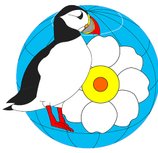Stranded
colorwork, 2 colors
26.06.2018
When you work with stranded color work it is important to make sure that you do not tighten the yarn too much. You also need to take care of your knitting tension, it is normal that color work will be knit a bit tighter than work with one color. If you knit a garment that has both, parts with one color and parts with 2 or more colors, it's especially important that the knitting tension is the same for the entire project. If you knit tighter with more colors, you can use a needle which is 0.5 - 1 mm thicker for parts with color work.
Example right side.
Knitting with 2 colors and to achieve just the right length of yarn for the floats requires some practice. If you find a way you feel comfortable with, it's easier, so try to find you method. Keep track of what's happening on the wrong side. Take your time and let the speed come with the practice.
Example wrong side
As you look at this picture, the floats should be just the right length compared to how many stitches you "jump" over. If the floats become too tight, the result on the right side becomes less nice. If they become too loose, you will permanently put fingers in the threads when you wear the garment.
Notice the distance between the stitches on the right needle in all pictures. The stitches are never close together on the right needle. This gives good control of the yarn floats. Always adjust the stitches on the right needle so that the stitches are at the same distance that they will be when the garment is finished. You will notice that you are doing the adjust automatically as you have received more exercise.
The way you normaly knit may determine which method you feel works best for you.
Method 1.
This picture shows the most common way of holding the yarn. Hold the contrasting color on your index finger and the main color in the right hand together with the knitting needle or lay it loosely on the wrong side. Knit the stitches that should be in contrasting color by picking up the yarn from the left index finger and use the right hand to knit the stitches in the main color.
Note! Keep the color who has the most stitches on your index finger. It is easier to get the correct float on the yarn in the right hand.
Method 2.
Another method is to hold both yarns with the right hand. It's a more time-consuming way to knit, but in return, you have better control on the floats and the tension.
Method 3.
You can also hold both colors on your left index finger. This requires more exercise, but it is easier to twist the yarn when necessary because you can pick the yarn from above or below the other color.
When and how to twist the yarn.
When working with stranded color work, you may twist the yarn to avoid long floats.
A golden rule is that if your color shifts is 5 stitches or more, you should twist the yarn. Also think of which garment you knit and the yarn thickness. If you knit socks or mittens, it's a good idea to twist more often to avoid fingers and toes that pull out threads and destroy the garment. A cowl or a sweater will usually be ok with 5 stitches without twisting. If the garment is for a child, it's a good idea to twist when you have knit 3-4 stitches in the same color.
The picture shows how to twist the yarn.
This photo shows that the pattern color has been attached. It is knitted 3 stitches main color before it is twisted and 2 stitches main color after the yarn is twisted.
Note list!
- Pay attention to your knitting tension/gauge.
- Pay attention to the wrong side of work.
- Do not tighten the yarn too much, it's better to knit a little looser than you do when you knit with one color.
- Use 0.5 to 1 mm thicker needles for color work if needed.
- When 5 stitches or more in the same color - twist the yarn.
- Make sure the stitches on the right needle are never tightly placed. #Always adjust the stitches on the right needle so that the stitches are at a distance that is the same as they should be when the garment is finished.
- Keep the color you want to knit the most stitches in, on your index finger. It is easier to get the correct tension on the yarn in the right hand.

